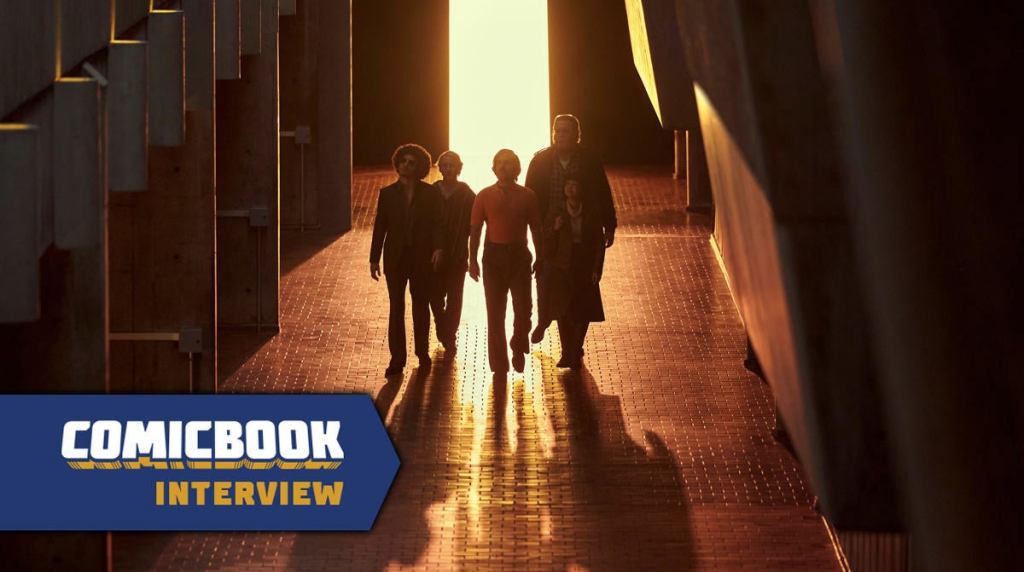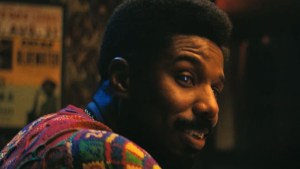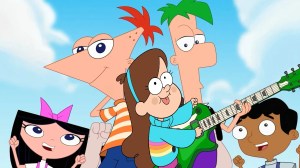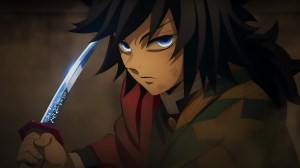While he might only have two feature films to his name, director Panos Cosmatos has established himself as one of the most singular voices in the world of genre cinema of the past decade, with no other filmmaker quite capturing the stories or style he’s put up on the big screen. From the bizarre sci-fi head trip of Beyond the Black Rainbow or the drug-fueled path of love and revenge seen in Mandy, featuring an all-time great performance from Nicolas Cage, there’s few visionaries out there quite like Cosmatos. In this regard, it’s no surprise that Guillermo del Toro, a similarly unique filmmaker, enlisted Cosmatos and Mandy co-writer Aaron Stewart-Ahn to develop an installment of his new Netflix series Guillermo del Toro’s Cabinet of Curiosities.
Videos by ComicBook.com
Netflix describes the series, “Guillermo del Toro — the master of horror — presents a collection of unprecedented and genre-defining stories that will challenge our traditional notions of horror. Guillermo Del Toro’s Cabinet of Curiosities is an anthology of sinister stories, told by some of today’s most revered horror creators — including the directors of The Babadook, Splice, Mandy, and many more.”
In Cosmato’s “The Viewing,” a group of strangers are brought together by an eccentric for a mysterious “viewing,” which is sure to change their lives forever. “The Viewing” stars Peter Weller, Eric André, Sofia Boutella, Charlyne Yi, Steve Agee, Michael Therrialt, and Saad Siddiqui.
ComicBook.com caught up with Cosmatos to talk developing the episode, working in an episodic structure, and whether he’ll be the next genre filmmaker to join Marvel’s roster.

ComicBook.com: Just the fact that this was a project coming from Guillermo del Toro, what was your own personal connection to him and what impact has he had on you as a storyteller?
Panos Cosmatos: Oh wow. I’ve always just really admired Guillermo’s visual acumen, and his knowledge of the genre is unparalleled. So it’s like getting to work with an amazing librarian/creative himself. I have the utmost respect for him and I was extremely stoked to be asked to do this.
I do like that initial reaction out of context is like, “Oh, working with Guillermo’s like working with a librarian.”
I mean that in the best possible way.
Oh, of course. I think the wealth of knowledge that he has over genre storytelling, absolutely, he’s like a custodian of the masters of horror. I totally see what you’re saying.
It was funny because he came to me with, I think, five different scripts that were already written, or short stories, but I prefer to create my own things from the ground up. I had a notion about what I wanted a short film to be, but it’s … Sorry, I lost track of the question and started answering a question you didn’t ask.
Literally that was going to be my next question. I was curious about how you and Aaron and Guillermo came together to develop this, if it was an entirely original idea, or it sounds like maybe it’s influenced by some idea Guillermo might have brought you?
No, ultimately I asked him if it was okay if we just generated our own story, me and Aaron. I had a notion about a collector, and I’ve always been fascinated by collectors, being one myself to a certain minimal degree, and I wanted to do something about addiction. Aaron and I were able to hash out this story that included both of them, I hope.
The cast of your episode is fantastic. Given that the people that you have in there, outside maybe Peter Weller, they’re comedic performers. Were they people you’ve just always wanted to work with and this was the right opportunity to fit the tone of the piece or was it a more traditional casting process?
Generally, it was almost entirely people that I wanted to work with. I’ve always wanted to work with Eric. I love him. I’ve always wanted to work with Peter, and I’ve always wanted to work with Sofia. Those are people that have been on my radar that I thought were amazing, that I wanted to give a little different window onto their abilities.
Once you actually brought them in, was there much evolution of the story? They get to have comedic bits of dialogue and comedic conversations, but were they pretty much all in on, “No, this is a horror story, so we need to serve that first,”?
I think of the story as two things. It’s both a horror story, it’s an addiction metaphor, and it’s also a Scooby-Doo cartoon. Really one of the biggest influences on the tone of it was Scooby-Doo cartoons and EC Comics.
I can totally see that. Along with that, and maybe that is a little bit of an answer, what I love about your episode and Beyond the Black Rainbow, your tone is definitely heightened, but it never feels ironic. It never feels like you’re intentionally leaning into campy elements of the genre. Was there much of a challenge when it came to finding that tone? Or since Scooby-Doo was an influence, were you just thinking, “Go as silly as you want, go as big as you want, and we’ll find it in the edit,”?
We did a lot of read-throughs as a group, so we found the tone, I hope, before we filmed. So that’s how the process went.
Speaking of Beyond the Black Rainbow, both in that and in your episode, the visuals are just absolutely insane. There are times where I feel like my mind is absolutely melting as I’m watching one of your pictures unfold.
Thanks, man.
So for you, whatever project you’re working on, do you have it in your mind of, “This is exactly how I want this image to come across,” or do you have just a concept and it’s a collaboration with the visual effects artist to get that vision across?
Usually, I have a very specific, distinct idea of what I want the ultimate thing to look like. But the great thing about working with extremely talented people is that their ideas are generally really good and their abilities are … They’re at the top of their field for a reason.
I knew I wanted to try to go even further with this look as far as using streak filters and star filters and things like that. So me and Mike [Ragen] worked to make sure we tried to make every shot special.
With this story and with some of your other stories, they really give us exactly as much information as we need while also cluing us in to this surreal, expansive world where there’s other people, there’s other characters, there’s other monsters like this that exist in this world. Once you told this story, did you see this as potentially the beginning of a bigger story? Do you feel you have more stories in this world to tell or was this a complete thing?
This is a complete thing. It is an EC comic, after all, and an episode of Scooby-Doo, so it does come to end.
Probably not necessarily from a budgetary standpoint or anything like that, but you’re limited to one episode, this is not a feature film. Were there any challenges, either from a storytelling perspective or a production perspective, any unexpected, maybe not even challenges, it could be even gifts, changing your sensibilities from making a feature film to making an episode of this anthology?
Well, generally when I write, I can’t speak for Aaron, but generally when I write a script alone, I’ll get to page 45, and then maybe I’ll have the ending, too. And then I’ll be like, “Now what?” So it’s easy to write 45 pages with a head full of steam and fire. Generally, I’ll start with the beginning of a film and then the ending as well, and then iterate the middle parts. But actually, I think this episode is a full feature in a sense, compacted. It’s just under an hour. I think it has a first act, a second after, and a third act.
Some of it’s a faster pace, some of it, not so much. I just wanted to put these actors in a room and have them interact with each other and see what came of that tonally.
It’s interesting because the scale of the episode is actually, production-wise, it was very similar to Beyond the Black Rainbow as far as there being a couple of location night shoots at the beginning, a little couple of days at some location at the end, and in the middle, just being on one set essentially for the entire shoot with a creature and stuff. It was very similar, only now I was dealing with a much more advanced crew who had just come off of doing Nightmare Alley, a lot of them, so they were really at the top of their game.
Since Mandy was this breakthrough thing at Cannes, I know a lot of indie genre filmmakers, they have a hit, and then big franchises are like, “Hey, come on in, have a meeting.” For you, do you have any interest in working on a production of that scope of, “Hey, here’s $200 million to do a Marvel movie,” is that even on your radar or is that not at all aligned with your sensibilities?
I would love to have $200 million to do a non-Marvel film. I honestly don’t think I need $200 million to do what I want to do, and that’s personal films, really.
I do like the idea of you being like, “Oh yeah, sure, I’ll do Blade for $200 million,” and you spend $10 million to make the movie, and then the other $190 million is just, you get to spend on a nice vacation.
Well, Lord knows I love Blade, and maybe if I’d been offered Blade in the New Line Cinema days I would’ve taken it, but not the Disney days, I don’t think. I don’t think I’m a Disney filmmaker.
Maybe they can somehow rein you in and say like, “Well, we just need slightly fewer head-melting sequences to get the TV-14.”
One thing about the melting heads was that they were all shot practically and composited, so that was a really enjoyable experience shooting that, the plates for the melting and exploding heads. That was fun.
Guillermo del Toro’s Cabinet of Curiosities premieres on Netflix on October 28th.
This interview has been edited for length and clarity. You can contact Patrick Cavanaugh directly on Twitter.








